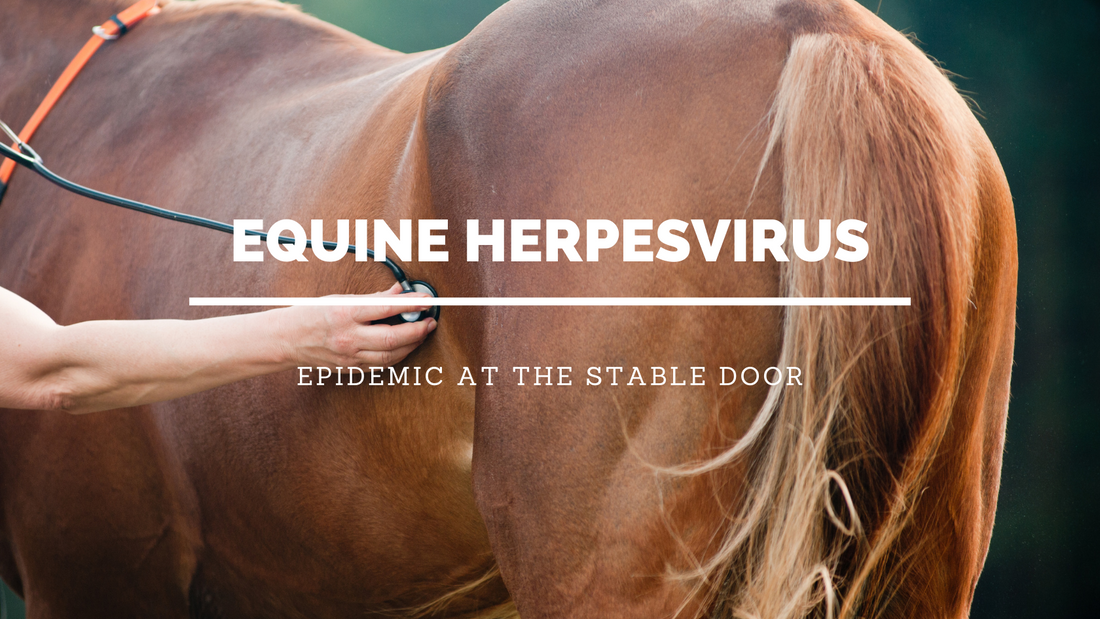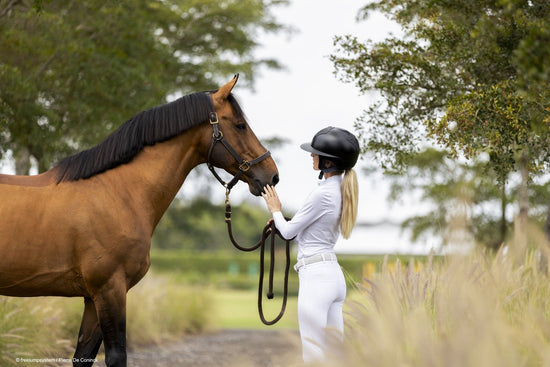The news about the CES Tour in Valencia being cancelled was spreading like wild fire. One horse tested positive for the Equine Herpesvirus (EHV) which made Charo Ortells (Show Director of Valencia CET Spring Tour) decide to stop the whole tour. All horses were tested and it has to be seen how many horses are affected by the virus.
But what is the equine herpes virus and how does it affect horses?
Again and again fatal cases of herpes in horses
Almost every year, mainly around late autumn and winter, herpes cases are reported. If the virus breaks out, it is highly contagious, leads to miscarriages, coughs, nerve damage and, not infrequently, death. What can you do about it? Vaccinate and strengthen the immune system!
The different forms and symptoms
There are different types of equine herpes virus (EHV), which express themselves in different secondary diseases:
- Equine Herpes Virus Type 1: There are diseases of the bronchial system, abortions and symptoms of paralysis
- Equine Herpes Virus Type 2: This type manifests itself in the eye as an inflammation of the eye (keratoconjunctivitis)
- Equine Herpes Virus Type 3: Blistering of the genitals ("breeding disease")
- Equine Herpes Virus Type 4: similar to type 1, Respiratory diseases, symptoms of paralysis
In horses, EHV 1 and 4 occur predominantly in three different forms with different symptoms.
- Virus abortion: broodmares give birth to dead or weak foals (only EHV 1)
- Rhinopneumonitis: Affected horses develop upper respiratory tract disease, have nasal discharge, high fever (40°C) and tarnished legs. In many animals, the respiratory tract infection turns into pneumonia
- Paralytic form: there are signs of paralysis (especially in the hindquarters) due to inflammation of the spinal cord, the affected horses are often stuck, cannot get up and usually have to be put down
EHV 2 infections
The herpes virus of type 2 is involved in the development of eye infections. They can also promote viral and bacterial infections of the respiratory tract.
EHV 3 infections
The EHV3 is usually transmitted from an infected stallion to the mare during mating. Around one to ten days later, circular vesicles and pustules appear on the vaginal vestibule, on the neighboring skin areas and on the udder. In sick stallions, the penis and foreskin are affected. There may be swelling next to the blisters.
How is it transmitted?
The EHV virus is transmitted via droplet infection and can spread rapidly. If a horse in the herd gets sick, it must be isolated from other horses immediately. If several animals are affected, it is advisable to close the entire barn. In order to avoid spreading, horses from an affected farm are not allowed to leave the barn. Special cleaning and disinfection measures also help to contain the spread. Herpes is not one of the animal diseases that have to be reported to the authorities, but it makes sense to inform the responsible veterinary office and the animal health service.
What can be done to prevent herpes in horses?
As with humans, around 90% of horses carry the herpes virus latently. Most horses become infected with the herpes virus in their first year of life. As long as the viruses are in a kind of sleep state, however, no clinical symptoms occur. In technical terms, this condition is called virus latency. If the immune system is weakened and under stress, the virus can reactivate. They multiply. Then the affected horse sometimes becomes ill itself. In any case, however, it excretes herpes viruses via the nasal mucus and thus becomes a source of infection for other horses.
The following measures can be taken to reduce the risk of an illness or outbreak:
- optimal housing and feeding conditions
- Strengthening the immune system
- Avoiding stress
- Vaccination of the entire (!) Herd
- regular cleaning and disinfection of the stables
- Beware of new horses at the stable (quarantine)
A strong immune system plays a particularly important role, as this keeps the penetration and replication rate of viruses as low as possible. On the part of feeding, the defense can be supported by cell protection vitamins such as vitamins E, C and beta-carotene as well as the trace element selenium. Omega-3 fatty acids (linseed oil or salmon oil) and zinc are also required for an efficient immune system.
Vaccinate against herpes
The vaccination against herpes in horses does not offer complete protection, but in the event of an illness it is much milder and the horses excrete less virus material. There are currently two different vaccines on the market. On the one hand live vaccine (EHV1) and on the other hand an inactivated variant (EHV1 and EHV4), which is used very often. Basic immunization against herpes with an inactivated vaccine provides for two vaccinations within about six weeks. The vaccination against herpes in horses unfortunately only lasts for a short time and has to be repeated every six months.
The role of lysine in equine herpes
Lysine is one of the essential amino acids, i.e. the protein building blocks that the body has to supply with food. Horse owners are familiar with the amino acid lysine mainly from supplementary feed for building muscle, but it also plays an important role in the subject of herpes. Veterinarians recommend feeding high amounts of lysine both preventively and in acute cases. Lysine is the antagonist of the amino acid arginine. This is mainly needed for the herpes virus to multiply. If there is a lot of lysine in the body, the lysine is mistakenly incorporated into the virus during the replication phase and thus it becomes inactive. The spread of the virus is thus contained.
Note: The equine herpes virus is a life-threatening infection for the horse and must be professionally looked after by a veterinarian! Even if the horse carries the virus but the herpes has not yet broken out acutely, constant attention and regular examination of the animal is essential.
Anyone who has ever had herpes at the barn will never forget it, especially the central nervous form. It is therefore important to optimize feeding (especially the supply of micronutrients) and keeping (species-appropriate, regular cleaning and disinfection, new horses in quarantine) and to vaccinate the entire horse population regularly.
Supplementary feed to strengthen the immune system
In order for the immune system to do its job, it needs, among other things, sufficient cell protection vitamins such as vitamins E, C, beta-carotene and selenium. Omega-3 fatty acids and zinc are also important.
Attention: Not only a deficiency, but also a massive excess of some vitamins and minerals can lead to health problems.
Equine herpes outbreak - what to do?
Prevent spread
The risk of infection is extremely high with herpes. The disease is often transmitted from one horse to another through droplet infection. But indirect contamination, for example through cleaning supplies, a halter, the feed bucket, the wheelbarrow, shared water points or people, is possible.
Horses suffering from herpes should be separated immediately from the healthy animals in the stable. They are also not allowed to come into contact with the feeder cart, cleaning equipment or other objects. The infirmary should be closed to visitors. Wear protective clothing while caring for herpes patients! Then move, disinfect hands and shoes.
Veterinarians recommend quarantining the entire stable for at least three weeks. No horse is allowed to leave the facility, no new horse is accepted.
Treat sick horses
The herpes viruses themselves cannot be combated with medication. Depending on the individual case, medication can help against symptoms such as inflammation and circulatory problems. In addition, the immune system should be supported.
Lysine slows down herpes viruses
The building block lysine is the antagonist of arginine. Arginine is important for the virus to multiply in the body. If there is a lot of lysine in the body, the virus incorrectly incorporates it and it becomes more difficult to multiply.
The herpes virus causes destruction and blockage of nerve cells. B vitamins in high concentrations promote the energy metabolism in the nerve cell and thus support the regeneration of the cell.
The big clean as aftercare
If the herpes outbreak is over, a basic disinfection of the stable is mandatory. Because the herpes virus can survive for several weeks in the affected stables. Do not forget saddles, blankets, cleaning supplies and tools such as pitchforks during the cleaning campaign.




